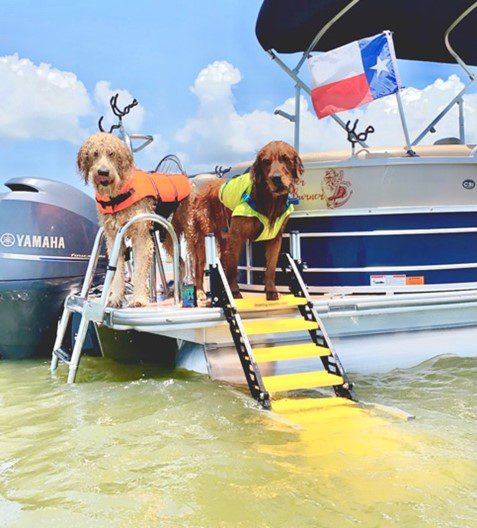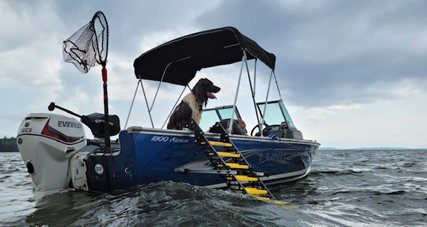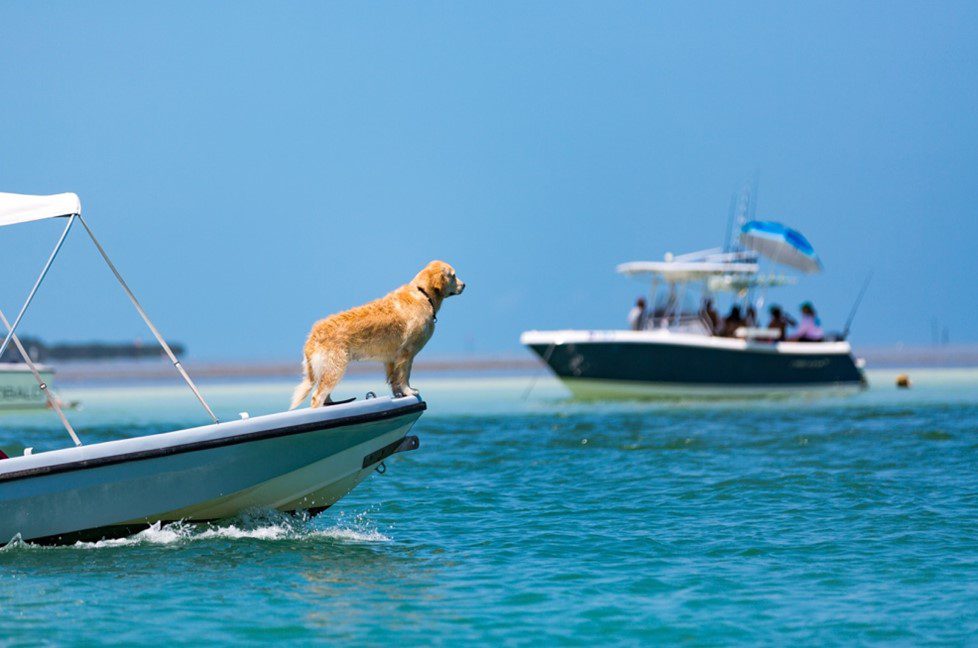That Time of Year: Prepare to Launch
This is an exciting time of the year for boaters. There may still be snow in the forecast in some parts of the country, but winter boat shows have us thinking about that first outing of the season. Whether you have a boat, recently changed to a different boat, or are first-time boat owners, proper preparation is key to making the boating experience a good one. To make sure you are ready to launch, among other things, smart boaters are thinking about having the right equipment onboard to ensure a safe outing. If you have a dog on board, that includes thinking about their safety.
Boating with Dogs: Learning from Experience
Most dogs love water and will jump in the minute they get a chance. I experienced it firsthand during our inaugural boat outing with our golden retriever, Katie. We had her restrained during the launch process. Once on the lake, we unleashed her and she jumped out of the boat into the lake where it was 60 feet deep. Being new boaters, we didn’t know what to do. Katie was enjoying her swim and we were in panic mode. It was too deep to drop an anchor and the boat was drifting with the power off. After several minutes with one of us in the water and pushing and another onboard pulling, we were able to wrestle her back in the boat and restrain her until we got to a sandbar. There, we let her swim until I got tired of lifting her back onto the boat’s swim platform. Needless to say, it was not as much fun as it could have been and we learned we needed to prepare better for the next boat outing with our dog. That same year, at an area lake by us in Wisconsin, a man drowned trying to save his dog that had jumped in the water. Most of us probably would have done the same thing regardless of how good a swimmer we were. We soon learned that, unfortunately, many dog owners drown each year trying to save their dogs. The Internet is loaded with stories we can all relate to. We thought back to our experience and realized we could have been another statistic. These two experiences shaped how we go boating with dogs now. 
The Right Stuff: Dog Boat Safety Items
There are several items that will make boating with your dog safer and more enjoyable. Besides the obvious like bringing food and water for the dog and keeping your dog away from boat propellers and hazards in the water, we recommend the following: Dog Restraint – Make sure you can restrain your dog when you want to keep them in the boat. The location and length of the restraint is extremely important. You will want to make sure they can change position, but not be able to jump down or out of the boat and choke or hang themselves. Depending on your boat design, a possible option is to loop their leash around a pedestal seat or table post. Keeping the anchor point down low and short enough that they can’t go over something and get caught is important. Test their freedom to move before leaving them unsupervised. Restraining your dog should only be done when necessary and for short periods of time like during launches or when preparing to pull or set your anchor. Make sure they have access to shade and water when restrained. Dog Life Jacket – Purchasing a life jacket for the dog, especially if they are not a strong swimmer, will keep them afloat and provide a handle for lifting them back in the boat. Like PFDs (personal floatation devices) for humans, they may also be referred to as life vests. The market is flooded with choices for dogs, but not all are constructed the same. Make sure the jacket is not too tight or too loose and the construction includes high quality stitching and attachments. A life jacket is only as good as the sewn connections, straps, and handles. Make sure the jacket is not rubbing or chafing the dog and that they can properly move their legs to swim. Also, make sure there aren’t any exposed flaps or straps that could get hooked on a water hazard. Dog life jackets are often a situation where you get what you pay for. Dog Boarding Device – Purchasing a boarding device so the dog can get from the water back into the boat on its own is the best solution for making boating with your dog safe and enjoyable. While dog life jackets will prevent them from sinking, it does not get them out of the water without you lifting them up and back on board. An injury to you or your dog while lifting can require expensive treatment and keep you off the water for the season. Even small dogs that can be easily lifted require you to set your drink down or interrupt what you were doing. If you are floating in the water, you aren’t even there to lift them back into the boat. Dog boarding devices, often referred to as dog ladders, allow your dog to come and go from the boat on their own without you needing to be there to lift them out of the water. The two most common forms of dog ladders are ramps and steps. As with dog life jackets, dog boat ladders are definitely a category where you get what you pay for. While most dog life jackets look similar, dog boarding devices or dog ladders are very different and there is a lot to consider besides price. 
Dog Boat Ladders: What to Consider
When purchasing a dog boarding device, there are several considerations for selecting the best solution for your application. Most importantly, the dog boarding device must be dog-friendly or your dog will get hurt using it or not use it at all.
A good, dog-friendly solution must:
- Extend far enough below the water surface for the dog to get all four legs on it. If the dog cannot get its rear legs on it to climb up, they will be forced to try to pull themselves up using their front legs only. The dog should not have to do gymnastics to get out of the water. They should be able to swim on and walk-up. In most cases for large dogs, you will want that low point to be 16 inches below the water surface. Small dogs can require as little as 8 inches below the water surface.
- Have a reasonable ascent angle. If the dog ladder is a set of steps, the ascent angle should be 45 degrees or less and the step height should be less than 8” with shorter being better for small or older, arthritic dogs. If the dog boarding device is a ramp, it should be 25 degrees or less. You should remember that the lower the angle will mean that the dog boarding device will need to stick out that much longer to provide enough surface under the water for the dog to get onto it. Think about where the end will be at your favorite tie-up or swim location.
- Be sturdy and not move when the dog steps on and applies its weight. Unexpected movement will scare the dog and they may not trust it. If the dog boarding service relies on buoyancy to function, it will definitely move when weight is applied. Keep in mind that not only will the device move (sink down), the ascent angle will increase. In addition, if the device has a high amount of solid surface area, water currents could cause excessive movement.
- Provide good traction for the dog to climb. Remember, there is water everywhere. Besides splashing, your dog may appear to be carrying and dumping half the lake up the device. If the boarding device is flat steps, make sure they are wide and deep enough. The easiest way to assess that is look at your dog’s paw prints in the sand and measure their track (width of all four prints) and the size of the paw print. Most dogs have tracks of less than 10 inches wide and paws less than 4 inches in diameter. The steps should be flat for comfort and have plenty of holes to prevent standing water as well as a toe plate or raised lip on the back of the step to prevent their feet from sliding off. If the device is a ramp, it will need cross-direction ribs and drain holes to prevent it from being a water slide.
- Provide good visibility. A dog’s color spectrum is limited to shades of gray, brown, yellow, and blue. Obviously, around water that, depending on the natural light and water conditions may appear blue, brown or gray, yellow is the best color for any dog ramp or steps.
In addition, from a boat owner standpoint, the solution should:
- Eliminate your need to lift the dog out of the water or be there to help. You should never let your dog swim unsupervised, but keeping an eye on them doesn’t mean you have to wrestle a dog back in the boat or set your drink down.
- Be easily deployed. If you don’t know already, you will quickly learn that when a dog sees water, they want in. The less time it takes to install, the less time you will hear them barking to go in. You also don’t want to take a toolbox with you every time you go boating. Look for products that, after initial set-up and adjustment for your boat, can be installed by any family member without tools, air pumps, or heavy lifting. You should also evaluate whether the device can be deployed without getting into the water. Dogs are very interested in swimming in water conditions much cooler than humans like such as spring and fall. A dog ladder or boarding device that can be installed without getting in the water and leaning over the edge of the boat will allow for a longer dog swim season.
- Be easily removed, stored, or transported. Just as in deployment, you will want to be able to remove easily and without tools. If you can’t store it on the boat, you will want to assess how heavy or cumbersome the product is for transport.
- Not scratch or damage the boat finish or components. Avoid products that have sharp corners or require metal parts contacting the boat. Contact components should be rubber or plastic.
- Be easily cleaned. Most boat dog ladders will remain clean since they are removed from the water after every use. However, in the event it was stored in a location where it did get dirty, you will want to be able to use a hose or pressure washer to clean it. As stated earlier, a yellow dog ladder is easier for the dog to see than one covered in brown dirt.
- Provide years of enjoyment. A good, high-quality dog ladder will be made of non-corrosive components and provide good UV resistance to withstand hours of sunlight. Hardware should be stainless steel. A dog ladder should not be considered a disposable item. A good one is not cheap and should last. You also should look for one where spare parts and technical support are readily available.

Final Thoughts
We have been boating with dogs for more than 18 years now. Sure, you could leave your dog home, but trust me, you and your family would be missing out on the enjoyment of water play with your dog. Swimming is one of the best exercise activities for your dog. There is nothing like a wet, wagging tail thanking you for bringing them along. Now, go have fun! Jim Perkins February 15, 2022 About the Author Jim Perkins is the Owner/President of WAG Products, LLC. His experience boating with dogs prompted him to design, develop and patent a dog ladder for his dog and boat that actually worked. As he shared what he was doing and listened to the needs of other dog owners, he introduced more designs. Today, WAG Products manufactures and sells a line of proprietary, American-made dog ladders under the brand name, WaterDog Adventure Gear® (WAG). WAG Boarding Steps™ are available for all types of boats, docks and swimming pools.


Recent Comments